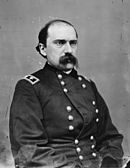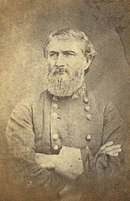Battle of Cassville
After the Atlanta campaign began in early May, Sherman maneuvered Johnston out of the Dalton position in the Battle of Rocky Face Ridge.
[3] The 25,000 non-combatants accompanying the army included railroad employees and repair crews, teamsters, medical staff, and Black camp servants.
Sherman's plan was to have Thomas and Schofield demonstrate against the northern end of the ridge while McPherson's two corps moved through Snake Creek Gap to threaten Resaca, Georgia.
[12] While Thomas and Schofield probed the strong Confederate defenses, McPherson marched through Snake Creek Gap on May 9 and reached the outskirts of Resaca.
Sherman then ordered Schofield and most of Thomas' army to march through Snake Creek Gap to join McPherson, leaving only Howard's IV Corps astride the railroad.
Johnston withdrew on May 12, concentrating his army at Resaca, and Howard's troops occupied Dalton, Georgia, the next day.
On the second day, Brigadier General Thomas William Sweeny's Union infantry division established a bridgehead on the south bank of the Oostanaula at Lay's Ferry.
[17] After occupying Resaca, Sherman sent Garrard's cavalry southwest toward Rome, followed by Brigadier General Jefferson C. Davis's XIV Corps infantry division.
He pursued a strategy where Thomas formed the center and pinned down the Confederates, while McPherson and Schofield strove to turn their flanks.
On May 16, Johnston briefly halted his troops 1 to 2 mi (1.6 to 3.2 km) south of Calhoun in the valley formed by Oothcaloga Creek.
[21] Johnston discovered that the creek awkwardly divided his army, so at 1 am on May 17, his soldiers abandoned the Calhoun position and fell back 7 mi (11.3 km) to Adairsville.
Wheeler's cavalry slowed down the advance of Howard's IV Corps by forcing the Union troops to frequently deploy.
From Kingston, Hardee would march rapidly east to join the other two corps at Cassville, whereupon the Confederates would attack the nearest Union forces a devastating blow.
Sherman ordered all his infantry formations to concentrate 4 mi (6.4 km) north of Kingston by the end of the day, but only Thomas' IV and XIV Corps made it that far.
[1] Two Run Creek flows southwest past the north side of Cassville, then goes west before draining into the Etowah near Kingston.
On the morning of May 19, Johnston issued a general order to his soldiers that they would attack their enemies, ending with, "I will lead you to battle".
[27] At 10:30 am, as Hood prepared to attack, one of his staff officers pointed out a column of cavalry advancing toward Cassville on the Canton road from the east.
Historian Albert E. Castel called it the "most valuable service" rendered by the Federal cavalry in the entire campaign because it prevented Hood from carrying out his potentially crushing attack.
[28] Hooker's leading division under Major General Daniel Butterfield detected Hood's move and hastily fortified.
[29] Union forces occupied Kingston on the morning of May 19, convincing Sherman that Johnston's army retreated south of the Etowah.
At noon, Howard's leading division marching toward Cassville from the west was confronted by Hardee's corps deployed into three battle lines and moving as if to attack.
Johnston personally selected a defensive line along a ridge that rose 140 ft (43 m) above the surrounding terrain and ran from the southwest to the northeast.
The Confederate chief of artillery, Brigadier General Francis A. Shoup argued that the new defenses were vulnerable to a Union barrage, but Johnston ignored his counsel.
More than 40 Union guns took Johnston's ridge under fire and Shoup's fears soon proved correct, French's division being especially hard hit.
[31] Believing that the fears of the corps commanders would be communicated to their men and thus weaken the army's confidence, Johnston yielded to these demands, even though he thought the position to be defensible.
He had just received a message from Brigadier General Lawrence Sullivan Ross that Union forces seized Wooley's Bridge on the Etowah.
After Hardee arrived at Johnston's headquarters, he was amazed to hear the army was going to retreat; he was not pleased but made no vocal objection.
This left Schofield vulnerable if the Confederate army suddenly turned on him, but Johnston was only interested in getting his troops to the south side of the Etowah.
[35] Historian Stephen M. Hood asserted that Johnston was not required to allow the advice of subordinates to overrule his own judgment.
However, because of Johnston's "great caution", Sherman's forces, despite being widely dispersed, advanced from the Oostanaula to the Etowah in only four days, with minimal casualties.








